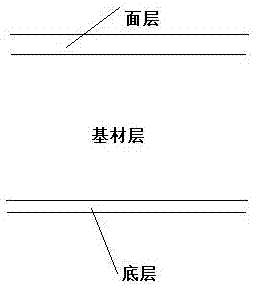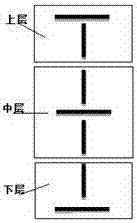Formaldehyde-free solid wood composite floor and manufacturing method thereof
A technology of solid wood composite flooring and manufacturing methods, which is applied in the direction of manufacturing tools, wood layered products, and joining of wooden veneers, and can solve the problems of strong permeability, low production efficiency of hot pressing, and large amount of glue coating, etc. Achieve the effects of low temperature and pressure, convenient production arrangement, and less glue coating
- Summary
- Abstract
- Description
- Claims
- Application Information
AI Technical Summary
Problems solved by technology
Method used
Image
Examples
Embodiment 1
[0059] Example 1: Production process of plywood base material for 13.4mm solid wood composite floor
[0060] 1) Veneer drying: Use eucalyptus veneers to pick out those that do not meet the requirements (such as decay, bark, large knot holes, etc.), and control the moisture content of the veneer at 5%-14% after drying.
[0061] 2) Veneer sorting: a. Excessive burrs are not allowed, a certain amount of burrs are allowed, and bark is not allowed; b. Decay and mildew are not allowed; c. Uneven thickness is not allowed.
[0062] 3) Veneer splicing: a. Place the tight side (smooth and less cracks) or loose side (rough and more cracks) of the veneer uniformly upwards or downwards, and use hot-melt adhesive lines to splice them into required specifications. b. The head-to-edge veneers need to have no arc at the end, the joints should be tight, and overlapping is not allowed. Problem veneers (uneven thickness, arc-shaped ends, insufficient length, decay, etc.) must be picked out before...
Embodiment 2
[0075] Embodiment 2: 15mm thick solid wood composite floor finished product production process
[0076] 1) Surface layer sorting: a. Moisture content is controlled at 6%-8%. b. The thickness of the surface layer should be uniform, the four sides should be straight, and the surface should be flat and smooth without burrs. c. The surface layer is not allowed to have decay, boreholes, fungal discoloration, garbage pollution, cracks, incompleteness, deformation of the surface layer, etc. d. The sorted surface layer should be trimmed, and the cut size is 1235*175*1.2mm.
[0077] 2) Bottom sorting: a. Moisture content is controlled at 10%-14%. b. The thickness of the bottom layer should be uniform, the four sides should be straight, and the surface should be flat and smooth without burrs. c. The bottom layer is not allowed to have decay, boreholes, fungal discoloration, garbage pollution, cracks, incompleteness, deformation, etc. d. The size of the sorted bottom layer is 1270*12...
PUM
| Property | Measurement | Unit |
|---|---|---|
| thickness | aaaaa | aaaaa |
| thickness | aaaaa | aaaaa |
| viscosity | aaaaa | aaaaa |
Abstract
Description
Claims
Application Information
 Login to View More
Login to View More - R&D
- Intellectual Property
- Life Sciences
- Materials
- Tech Scout
- Unparalleled Data Quality
- Higher Quality Content
- 60% Fewer Hallucinations
Browse by: Latest US Patents, China's latest patents, Technical Efficacy Thesaurus, Application Domain, Technology Topic, Popular Technical Reports.
© 2025 PatSnap. All rights reserved.Legal|Privacy policy|Modern Slavery Act Transparency Statement|Sitemap|About US| Contact US: help@patsnap.com



